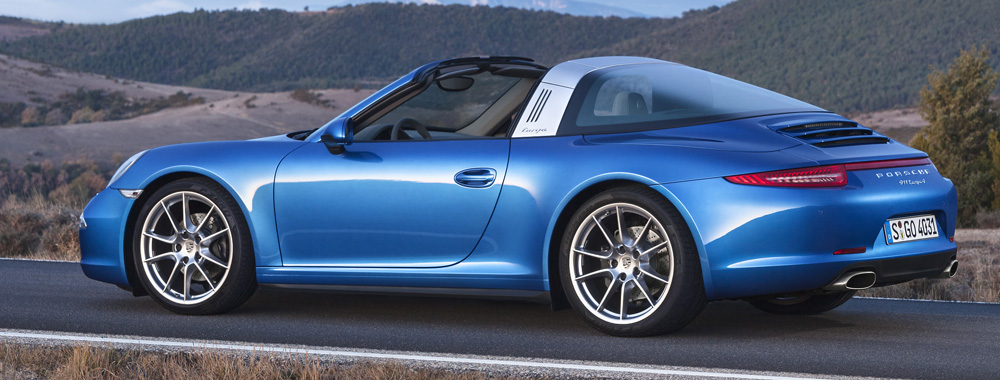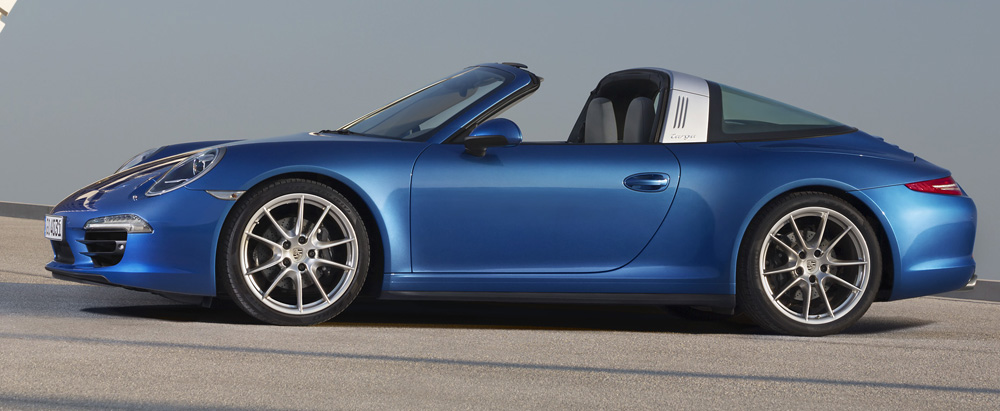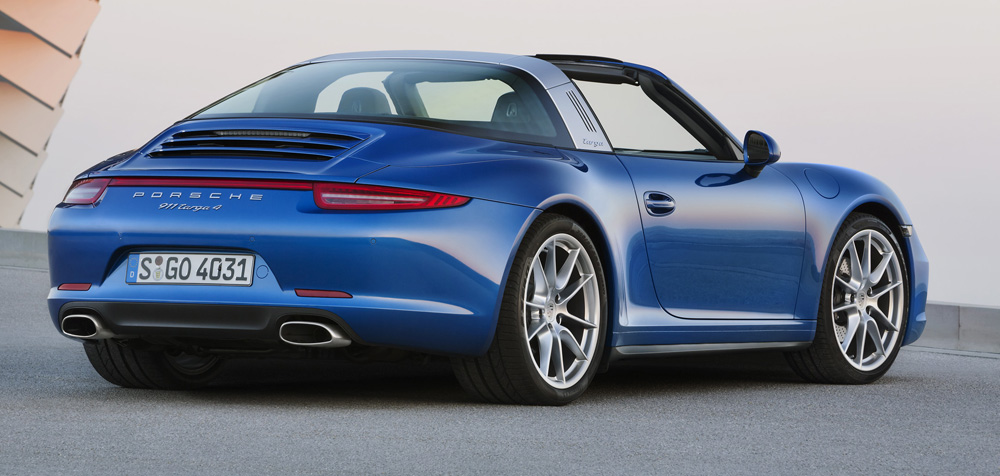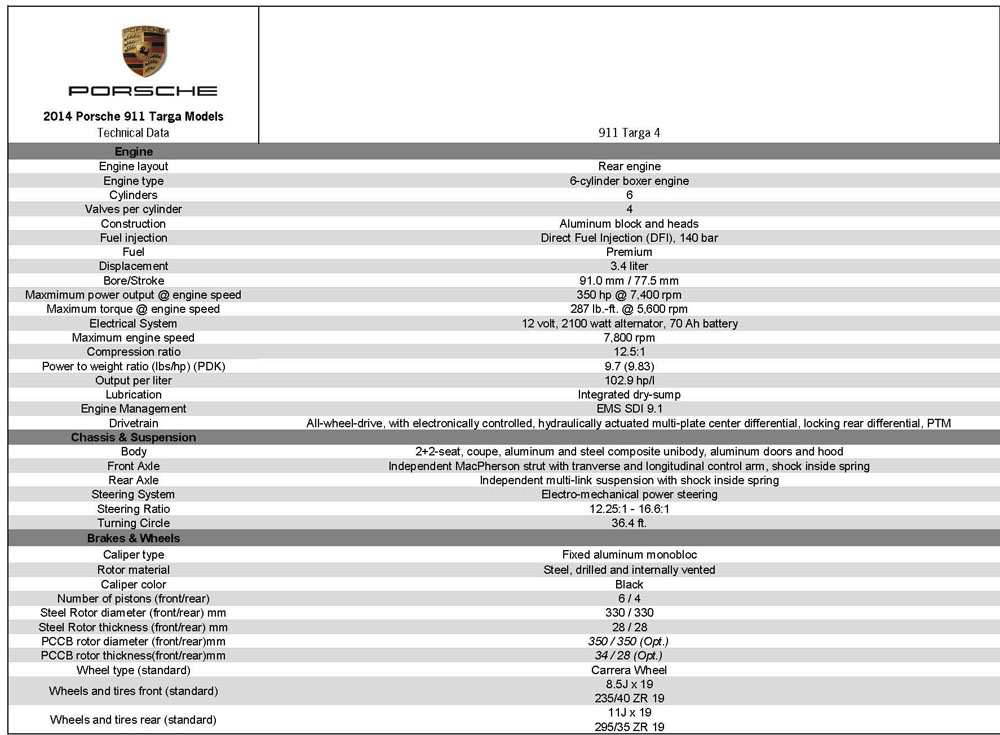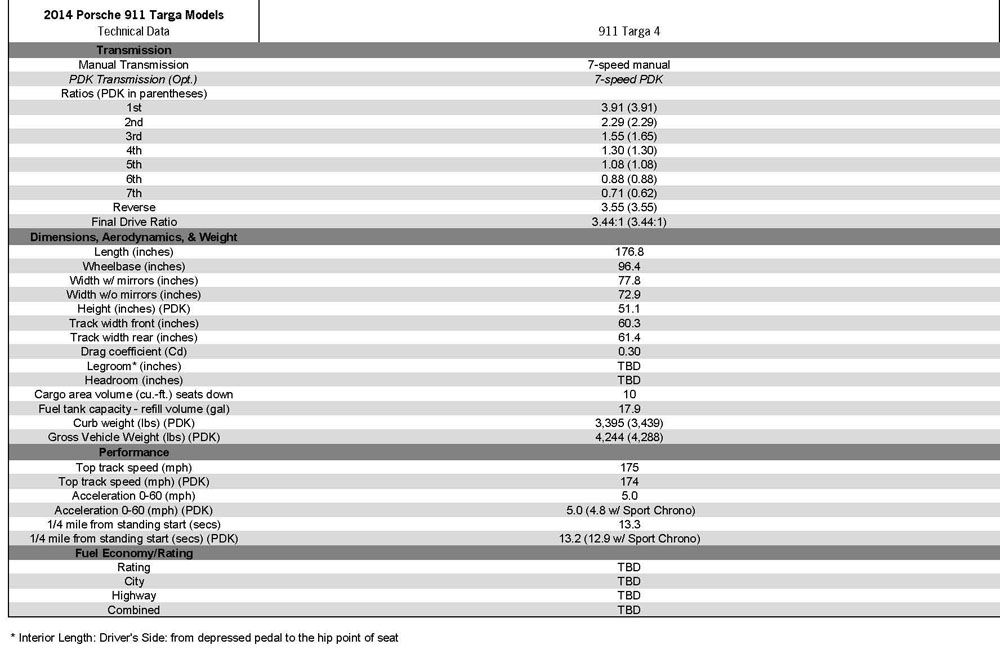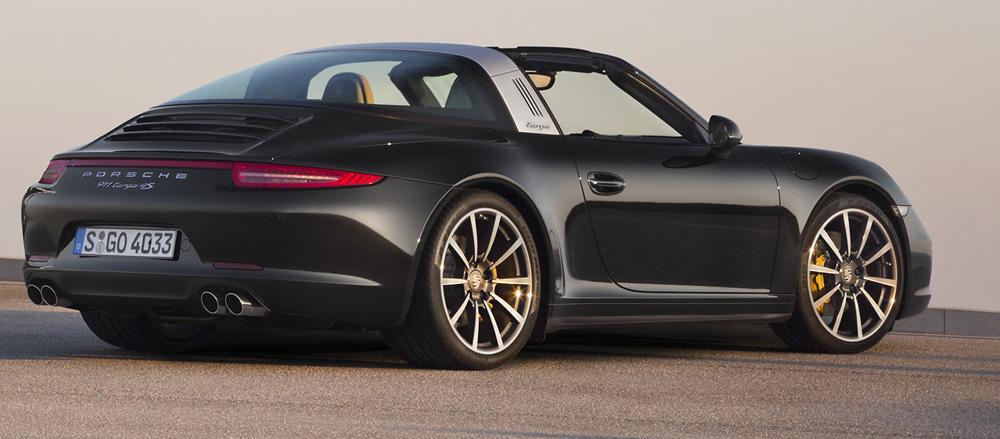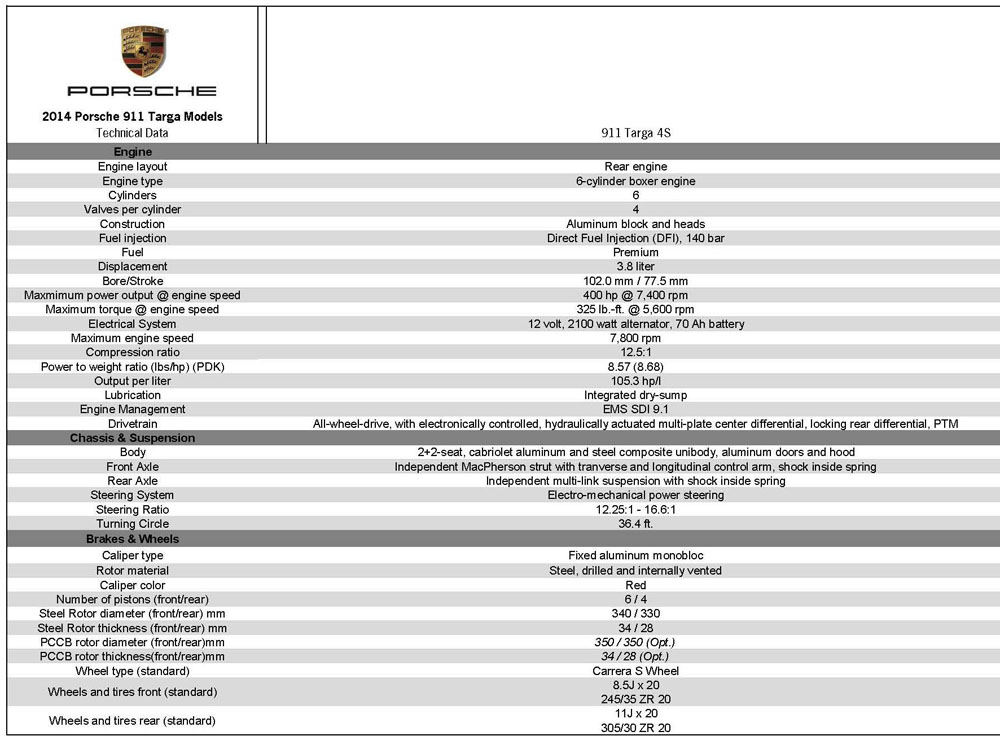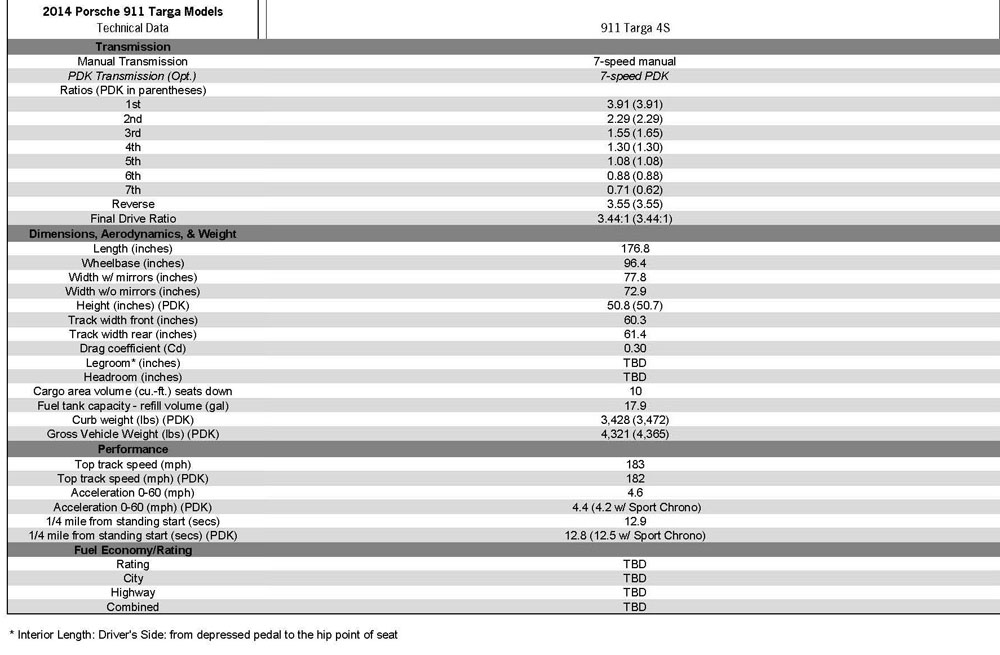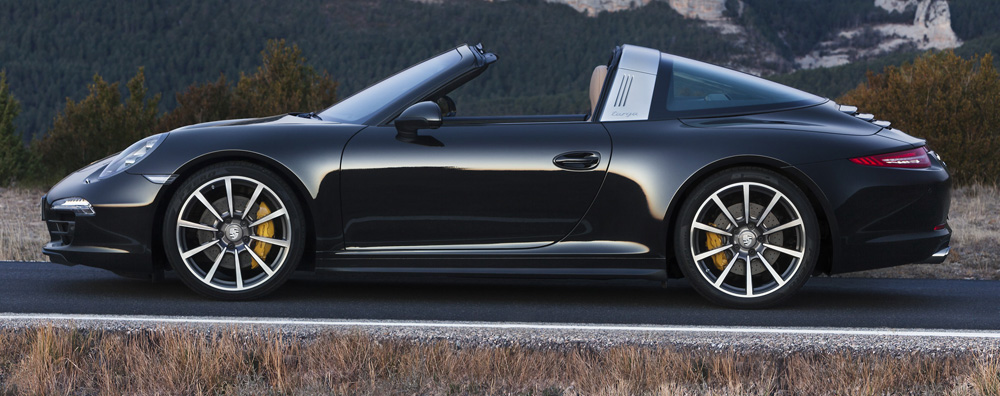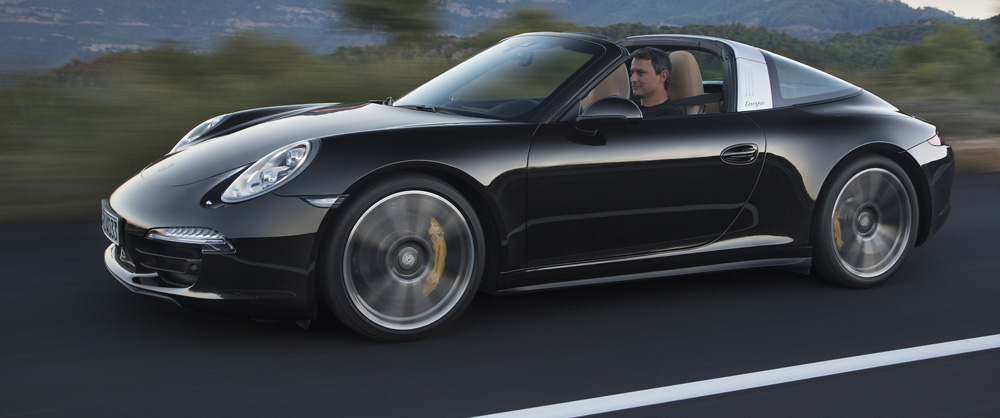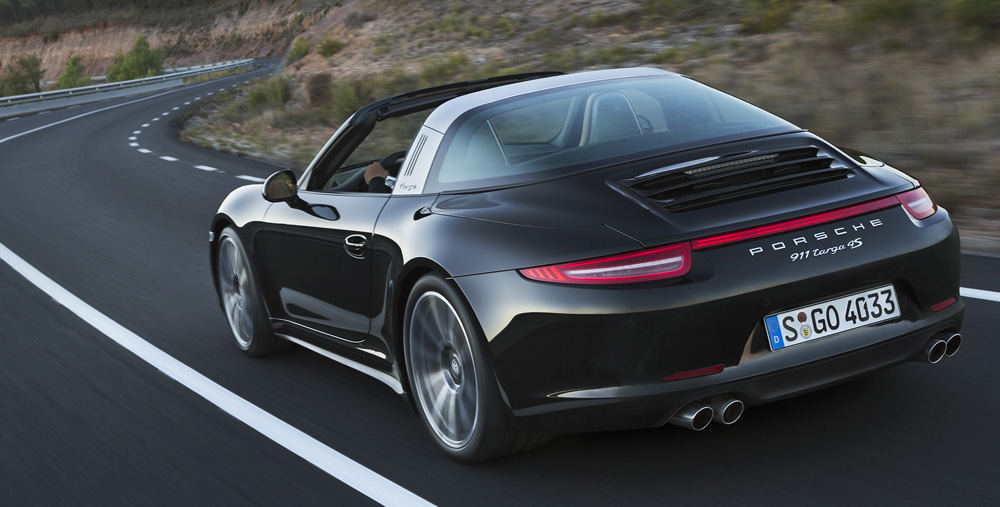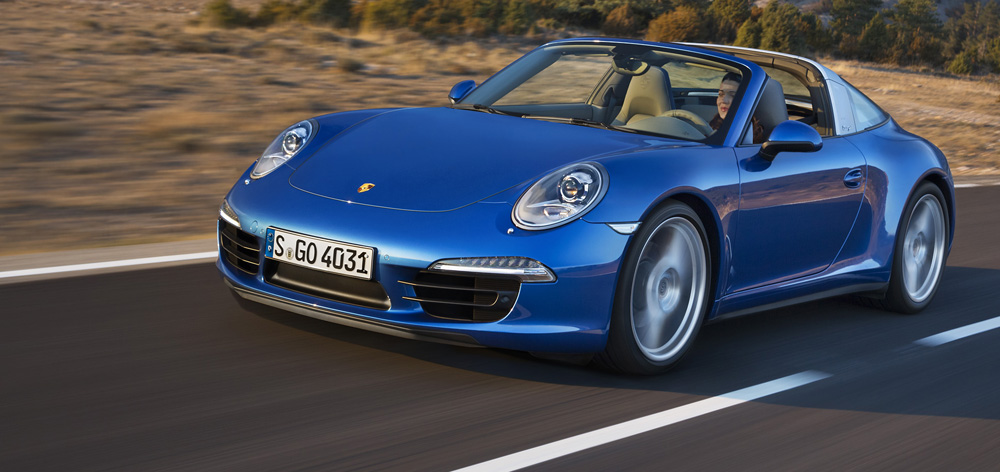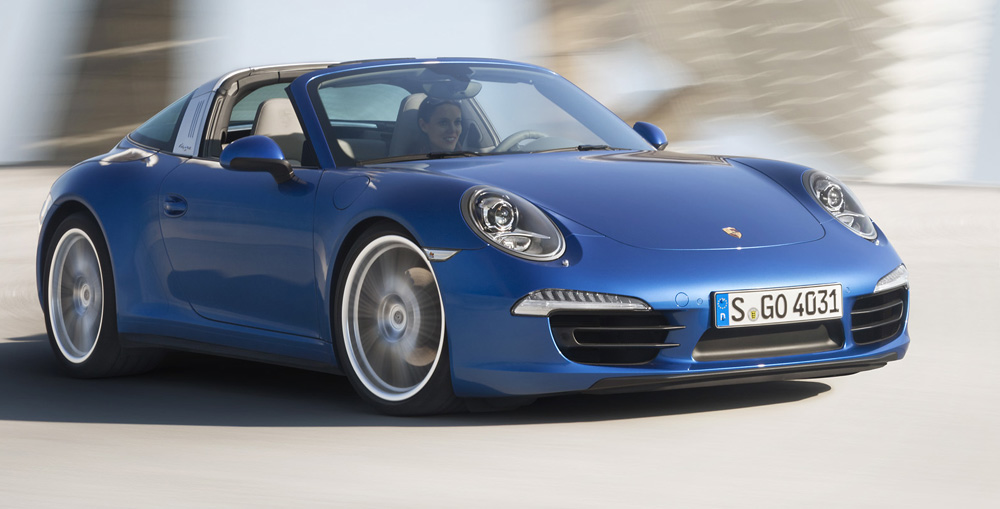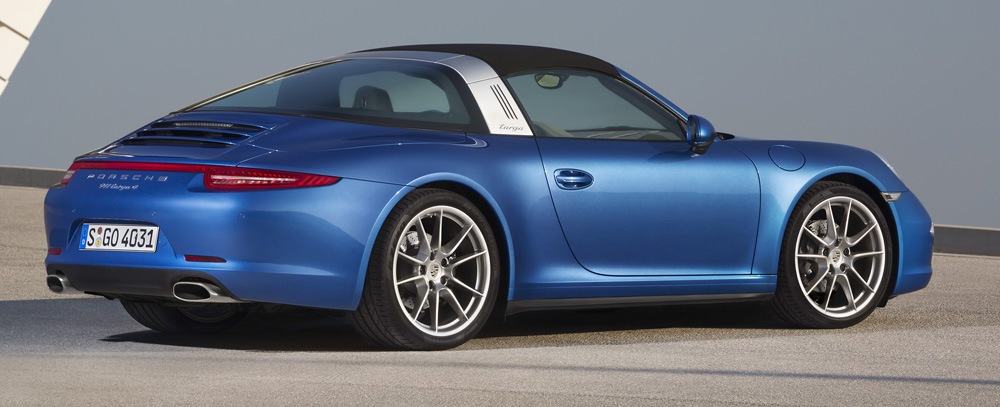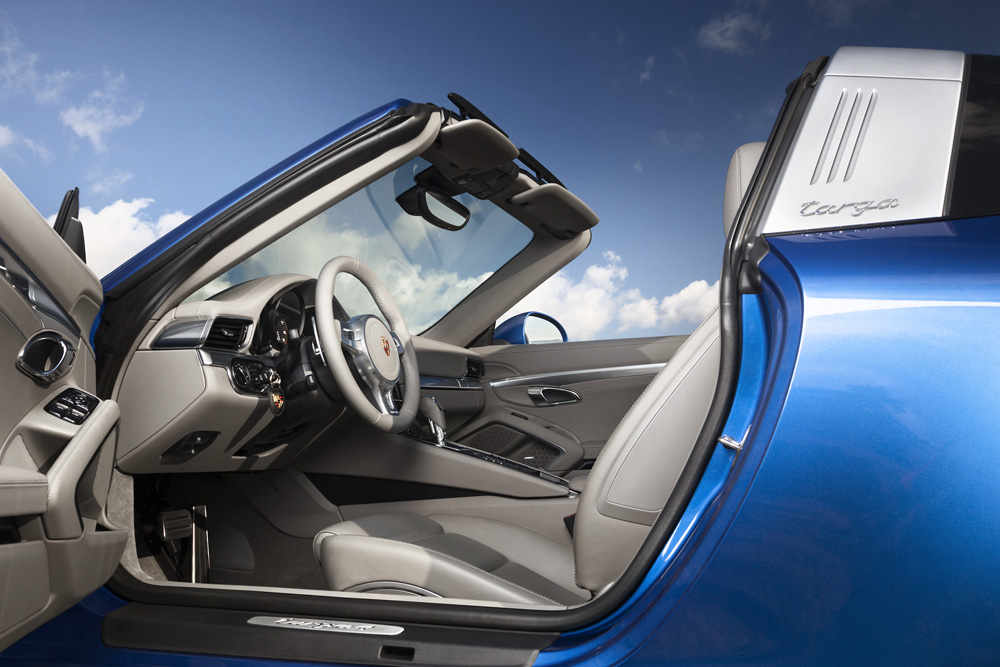A modern classic reborn
Porsche is expanding the 911 line with two new models: the 911 Targa 4 and 911 Targa 4S.
These new models are the first to combine the classic Targa concept with state-of-the-art
roof technology. Just like the legendary original 911 Targa, the new models feature the
distinctive Targa bar, a movable front roof section and a wraparound rear window. But un -
like the classic 911 Targa, the roof segment can open and close at the push of a button.
The fully automatic roof system stows the Targa top behind the rear seat.
The 911 Targa models feature a wider rear end and the same Porsche Traction Management
(PTM) system found in the 911 Carrera 4 and Carrera 4S all-wheel-drive models. It is an
active all-wheel-drive system that helps to ensure the optimal distribution of drive power for
optimum traction in most road scenarios, whether on long straights, through tight corners,
or on surfaces with different friction coefficients. The combination of the wide body, the Targa
bar and the wraparound rear window exude an extremely sporty and a low-slung profile.
The 911 Targa 4 is powered by a horizontally opposed 3.4-liter 6-cylinder engine with 350 hp.
Equipped with the Porsche Doppelkupplung (PDK) and the Sport Chrono package, the
911 Targa 4 accelerates from zero to 60 mph in 4.6 seconds and is capable of a top track
speed of 174 mph. The 911 Targa 4S delivers 400 hp from its 3.8-liter horizontally opposed
6-cylinder engine; and is capable of accelerating from zero to 60 mph in 4.2 seconds when
equipped with PDK and the Sport Chrono package. The Targa 4S is capable of reaching a
top track speed of 184 mph when equipped with a manual transmission and 183 with PDK.
The 911 Targa 4 will be priced from $101,600 while the 911 Targa 4S model is priced from
$116,200. Both cars also have a destination charge of $995. Deliveries of the 911 Targa
are scheduled to begin in summer 2014.
The fully automatic Targa roof
The Targa roof system has always been an unmistakable hallmark of the 911 model. The new
911 Targa continues this tradition with an innovative roof concept. The roof is made up of
two movable parts: a soft top and a glass rear window. The rear window, which is attached
to the convertible top, is opened and tilted rearward at the push of a button. At the same
time, two flaps open in the Targa bar, releasing the soft top's kinematics. The convertible
top is released, folded into a Z-shape as the roof opens and stowed away behind the rear
seats. Once the top has been stowed, the flaps in the bar and the rear window close once
again. The roof takes around 19 seconds to open or close while the vehicle is stationary.
A wind deflector integrated in the windshield frame can be erected manually when the top
is down. This deflector reduces wind and buffeting in the interior for the driver and passenger.
Intelligent lightweight construction using steel, aluminum and magnesium
The materials used in the roof system are just as innovative as the technology. The premium
quality fabric is stretched by the magnesium roof shell. The fabric and magnesium roof con -
struction is the same technology found in 911 Cabriolet models. Additional sound deadening
with thermal-insulation reduces road noise when the roof is closed. The rear edge of the
soft top connects to the fixed Targa bar, which features steel reinforcement on the inside
and painted cast aluminum elements on the outside. The three gills and "targa" lettering on
the sides of the bar pay homage to the original Targa.
The rear window, which is made from extremely lightweight laminated safety glass, consists
of two layers of thin, partially pre-tensioned glass separated by a film interlayer. The very
fine heating elements on the heated rear window cover almost the entire surface of the glass,
ensuring exceptional all-round visibility even in adverse weather conditions.
Drive concept designed for sportiness, safety and comfort
The new 911 Targa generation has been designed specifically with sportiness, safety and
comfort in mind. The power of the flat six-cylinder engine is transferred via a seven-speed
manual transmission as standard, while the automatic seven-speed PDK is available as an
option. The intelligent all-wheel drive system Porsche Traction Management (PTM) is re -
sponsible for distributing the power to the four wheels. The PTM consists of an active allwheel
drive with electronically map-controlled multi-plate clutch, Automatic Brake Differential
(ABD) and anti-slip regulation (ASR). This system helps with vehicle stability, traction and
agile handling. The PTM also directs the engine torque, to the front wheels via the multiplate
clutch. The level of torque is visible to the driver at all times via the 4.6-inch TFT color
display on the instrument cluster.
PTM: delivering a typical Porsche blend of sportiness and efficiency
In Sport Plus mode, which is available with the optional Sport Chrono package, PTM enhances
driving performance even further. When the driver activates the "Launch Control" function,
the PTM clutch is pre-tensioned to achieve even better acceleration from stationary standing
start. To increase efficiency, the PTM is able to determine the most economical driving style,
depending on the specific road situation and the driver's preferences. The system can re -
duce the level of drive torque transferred to the front axle to reduce friction losses. When
equipped with the 7-speed PDK, the 911 Targa also benefits from the "coasting" function,
which releases the PDK and the PTM clutch. This reduces the braking torque of the all-wheel
drive system, while reducing fuel consumption.
911 chassis with specific Targa tuning
The chassis of the new Targa is largely derived from the 911 Carrera all-wheel models.
The wide-track rear axle in combination with the PTM all-wheel drive offers excellent stability.
Passive shock absorbers form part of the standard equipment on the 911 Targa 4. The
S model is equipped with Porsche Active Suspension Management (PASM) as standard.
This active shock-absorber system is also available as an option for the standard model.
Both chassis have been specially tuned for the 911 Targa and also feature rebound buffer
springs on the front and rear axle, which optimize performance through turns.
For greater speed and stability through turns: Porsche Torque Vectoring
The Porsche Torque Vectoring (PTV) system is included as part of the standard equipment
on the 911 Targa 4S and is available as an option for the 911 Targa 4. The system comes
in two versions, PTV, which is used in combination with the manual transmission and fea -
tures a locking mechanical differential, and PTV Plus with an electronically controlled fully
variable locking differential for vehicles equipped with the optional PDK transmission. The
PTV/PTV Plus systems enhance vehicle agility and steering precision by initiating braking
on the inside rear wheels. The locking differential improves traction when accelerating out
of turns.
An even sportier drive at the push of a button:
From the "Sport" button to the Sport Chrono package
The "Sport" button comes standard in all 911 models. With this button the driver can choose
between a more comfortable and fuel efficient driving mode or a more performance orien -
ted driving mode. The optional Sport Chrono package with the additional "Sport Plus" button
enables an even greater blend of performance and driving comfort in everyday driving
scenarios. In addition to adjusting all the relevant systems and functions to deliver maximum
performance, the Sport Chrono package also includes dynamic engine mounts.
Porsche Dynamic Chassis Control for a performance boost
Even greater dynamic performance and comfort is delivered by the Porsche Dynamic Chassis
Control (PDCC), which is available as an option for the 911 Targa 4S. This system delivers
impressive lateral acceleration and handling. The vehicle's variable stabilizer system reduces
roll angles to maintain optimum tire contact to the road surface, allowing for maximum
traction and acceleration. This increases the speeds achievable through turns, while driving
on straight roads the anti-roll bars are disengaged, which increases driving comfort.
Interior with typical Porsche ergonomics
The dashboard features the classic five round gauges with a center tachometer and a highresolution
4.6-inch color display. The forward-sloping center console is where the controls
for the roof system are located among other features.
The roof is lined with black fabric and the Targa bar features black Alcantara®. The convertible
top compartment is behind the rear seat and together with the transverse strut serves to
integrate the stowed convertible top into the cabin. Even with the roof closed, the large
curved rear window allows plenty of light into the interior, providing a unique feeling of space.
The history of the Porsche 911 Targa
Porsche unveiled the 911 Targa, the world's first ever "safety Cabriolet", back in September
1965 at the Frankfurt International Motor Show (IAA). With its fixed targa bar, removable
folding roof, removable soft rear window, and this new variant was developed primarily in
anticipation of safety regulations in America. The name "Targa" comes from the famous Targa
Florio race and since the mid-sixties has been synonymous with the open driving concept.
Production of the vehicle began towards the end of 1966 with the market launch of the
911 Targa taking place in 1967. This roof concept was enhanced from one 911 generation
to the next over a period of 27 years. During this time, this "semi-open" variant acquired
the status of a stand-alone vehicle concept in the Porsche model range.
For the 1996 model year, Porsche presented a fully reworked version of the 911 Targa
(the type 993). The entire roof was made of glass with a sliding glass cover at the front
that could be lowered and retracted beneath the hinged rear glass window.
Twenty-one years after the last 911 Targa with the classic Targa bar based on the type 964
was discontinued, the new generation is once again taking this original style into the future.
